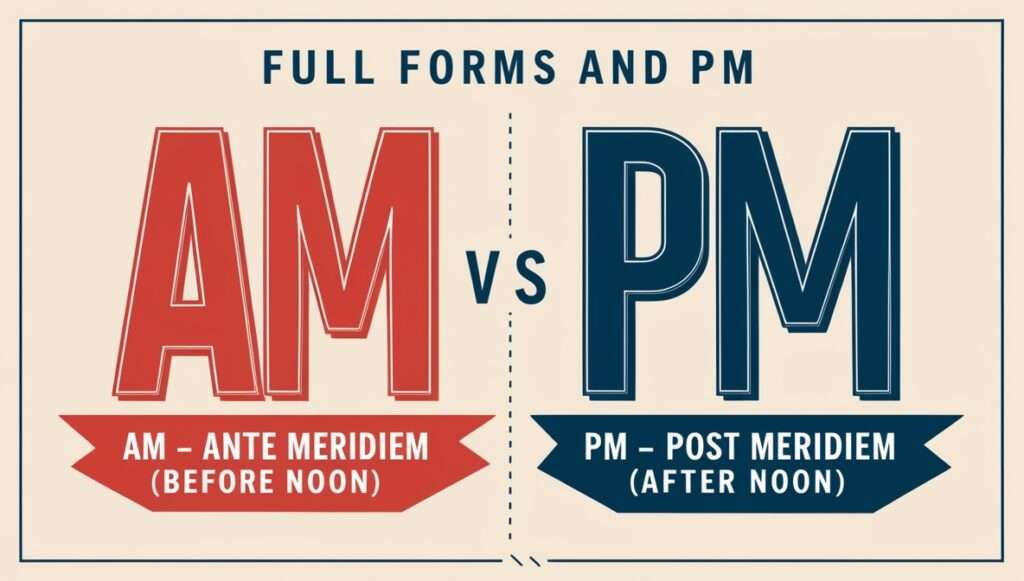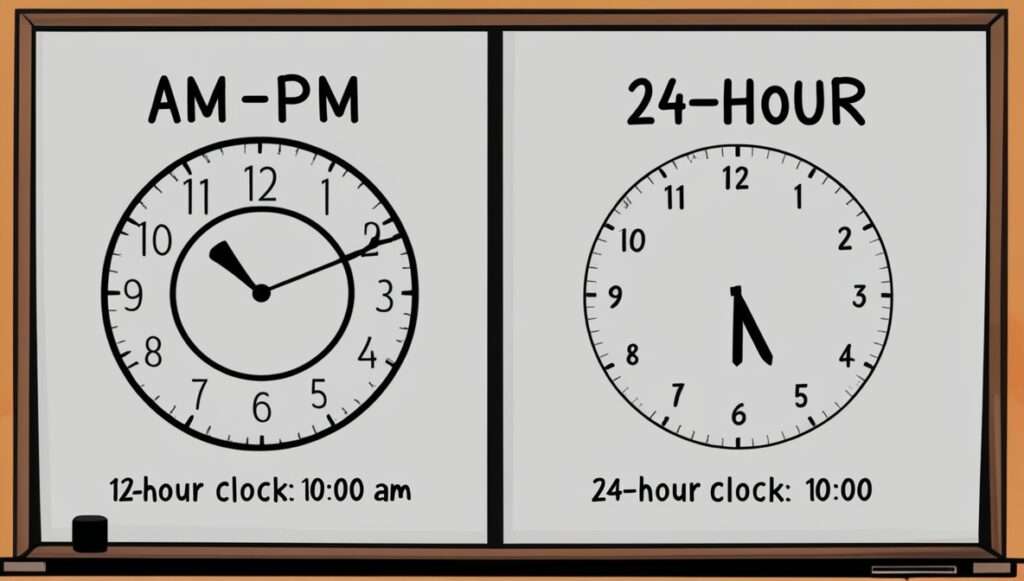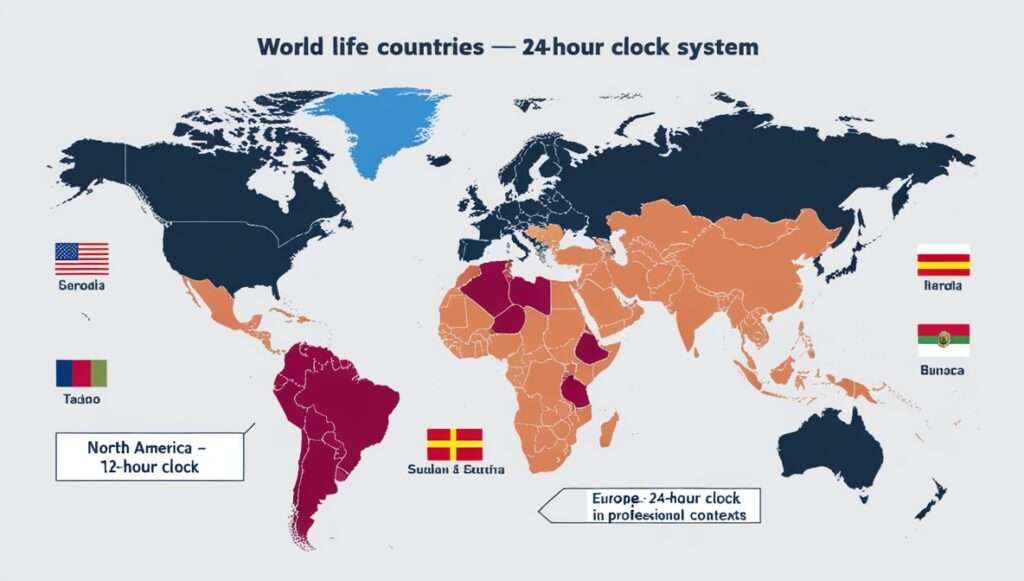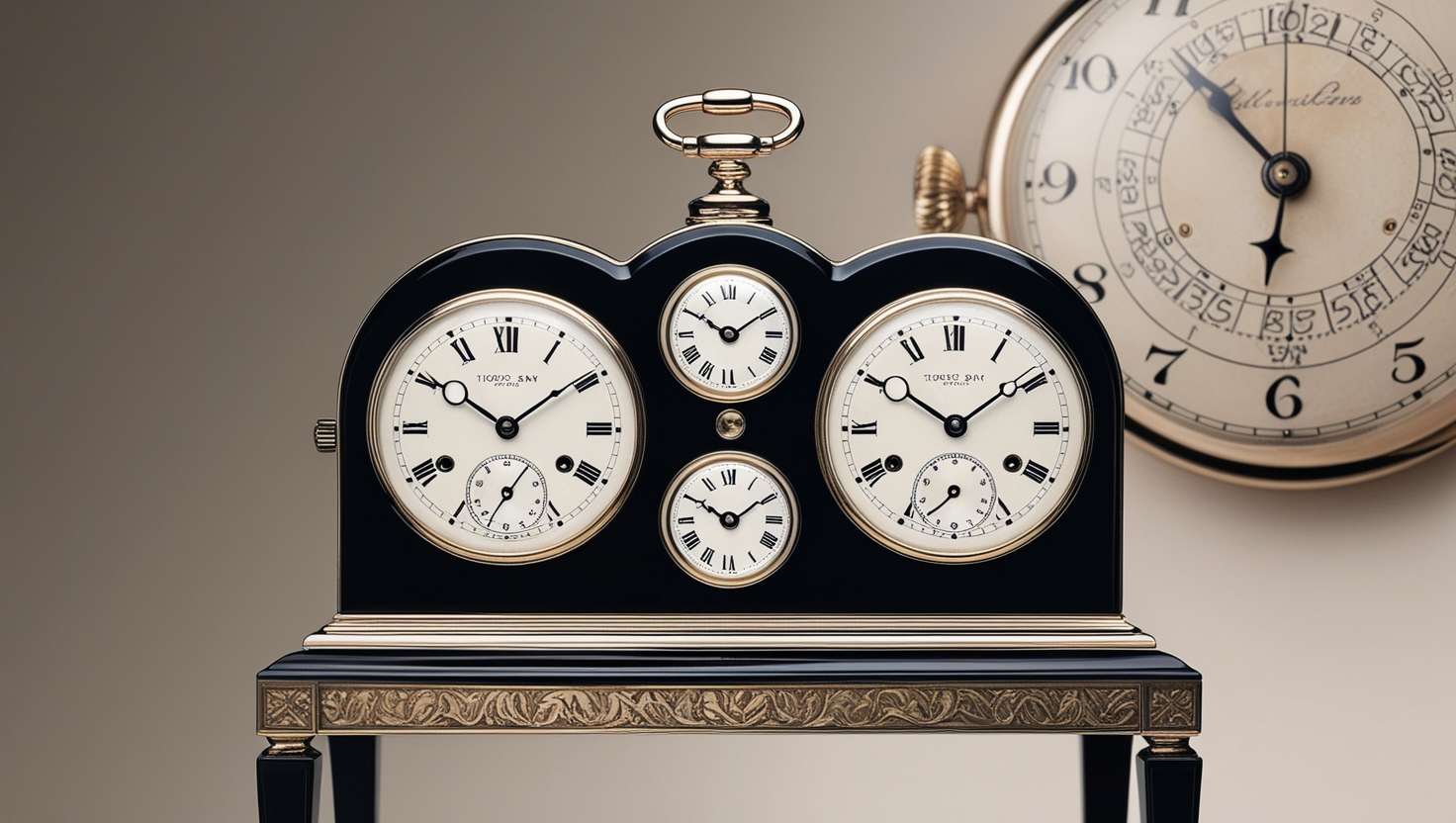Table of Contents
ToggleIntroduction
Ever thought about what AM and PM mean, or why they’re everywhere when we talk about time? They come from Latin words – ante meridiem for AM, meaning before midday, and post meridiem for PM, which means after midday. These terms are key parts of the 12-hour clock system that’s used in lots of places around the globel. This piece dives into what these abbreviations stand for, their backstory, and how they fit with the 24-hour clock system. For more information and FAQs on the full forms of AM and PM, visit Vedantu’s dedicated web page.
Understanding Full Form of AM and PM
AM and PM aren’t just ways to tell time, they split the day into two halves of 12 hours each. AM, which stands for ante meridiem, covers the time from midnight all the way up to noon, encompassing the first 12 clock cycles of the day. On the flip side, PM means post meridiem and it takes over from noon until midnight hits again, covering the second 12 clock cycles of the day.
By using AM and PM, we get a handy system that helps us picture our day in chunks of 12 hours. This is super useful when planning out what happens when. Without these terms, things could get pretty confusing, especially if you’re trying to pin down specific times for meetings or events in writing or more formal chats. However, the need for AM and PM in the first place stems from the 12-hour clock format and the convenience of dividing the day into two cycles.

Full Form of AM and PM
To really get what AM and PM are about, it’s important to know where they come from in Latin. Ante meridiem,
Full Form of AM – The full form of PM stands for Post Meridiem, which comes from Latin.
which is the full form of AM, means “before midday” It’s all about the time that starts at 12:00 AM, which is when we say it’s the start of the day, and goes until 11:59 AM. AM, or Ante Meridiem, is a unit of the time standard that refers to the first period of the 12-hour clock system. It is related to the 24-hour clock system, which splits a day’s time cycle into two parts.
Full Form of PM – The full form of PM stands for Ante meridiem, which comes from Latin.
On the flip side, PM stands for post meridiem and this one means “after midday” This period kicks off at 12:00 PM and wraps up at 11:59 PM, signaling the end of the day. Even though these terms seem simple enough, there can be some mix-ups sometimes. Especially with figuring out times like noon or midnight. Getting these moments right helps everyone avoid getting things mixed up.
The Significance of AM and PM in Timekeeping
In our busy lives, full of deadlines and tight schedules, the way we split up the hours of the day into AM and PM is super important. It breaks down a whole 24-hour cycle into two chunks that are easier to handle for planning out what we do.
Think about trying to set up a meeting at 8 o’clock but not saying if it’s in the morning or evening. That could really mess things up, right? People might show up at completely different times!
The clock system with its AM (morning) and PM (evening) labels helps us avoid all that mix-up. It makes sure everyone knows exactly when they’re supposed to do something, making our days run a lot smoother.
The Historical Origins of AM and PM
The beginnings of our 12-hour clock system, including AM and PM, go way back to old times. It’s a bit foggy on who exactly started it all, but it looks like the Egyptians and Babylonians were some of the first folks to break down the day into chunks. This step towards keeping track was crucial for coming up with the 12-hour setup we’re familiar with now. Even though those abbreviations AM and PM popped up after, splitting days into two parts is an idea that’s been around since ancient civilizations.
How AM and PM Were First Used
From what we’ve gathered, the idea of splitting a day into 12 hours goes way back to the second millennium BC. It seems like the Egyptians were pretty ahead of their time, using sundials when it was bright out and things like the Egyptian water clock after dark.
There’s this cool bit in history about how inside the tomb of Pharaoh Amenhotep, there’s clear evidence they had this 12-hour clock setup going on. They didn’t use terms like AM and PM to tell one half from another, but they definitely broke down days and nights into 12 chunks each. This practice can be traced back to ancient Egypt, where both an Egyptian sundial for daytime use and an Egyptian water clock for night-time use were found in the tomb of Pharaoh Amenhotep I, dating back to 1500 BC. This shows the long history and use of the 12-hour clock, originating in ancient Egypt.
Later on, even the Romans got on board with a similar kind of clock system. This whole concept really caught on over time across Europe before making its way around globe.
Evolution of the 12-Hour Clock
By the 16th century, clocks that could show hours started to pop up everywhere, making it normal for people to use the 12-hour system. Later on, when they added a hand to count minutes, our way of looking at time got even better. This is how we ended up with the hour clock as we know it today.
With more places using this 12-hour setup, there was a need to tell morning and afternoon apart clearly. So by around the 17th century AD, everyone began using AM and PM more often. These terms come from Latin – ante meridiem meaning before midday and post meridiem meaning after midday – offering an easy way to say if it’s before or after noon without any confusion.

AM and PM in the Context of the 24-Hour Clock
While most people are familiar with the clock format that splits the day into AM and PM, there’s another way to tell time called military time or the 24-hour system. This method counts straight from 00:00, which is midnight, all the way up to 23:59, right before it hits midnight again. This system is often used in the military and other professions that require precise timekeeping, as it eliminates any confusion about whether a time is in the morning or evening. Additionally, using the 24-hour clock allows for a more accurate measurement of time as it is based on the unit of time, rather than the arbitrary division of AM and PM.
With this approach, you don’t have to worry about mixing up AM and PM since each hour of the day has its own unique number. However, how much this system is used can really depend on where you are in the world or what situation you’re in. It’s pretty important to get a handle on both these time conventions, especially because we live in a big world filled with different time zones and ways of keeping track of time.
Differences Between the 12-Hour and 24-Hour Formats
The big difference between the 12-hour and 24-hour clock is how they display the hours of the day. In a nutshell, with AM and PM, the 12-hour system splits the day into two halves to tell time, while in contrast, from midnight starting at 00:00 up until it hits 23:59 right before a new day begins, is how the full-day cycle rolls in a continuous manner using the 24 hours format, also known as military time.
When it comes down to picking one over another, where you are and what’s usual there plays a big role. For just going about your daily stuff in lots of places around the world, people stick with talking about morning or night times using AMs and PMs. On flip side though,military time, which doesn’t need those extras because its all numbers straight through – this gets thumbs up for use by folks working within healthcare circles or flying planes not forgetting armies too; here being clear as bell without any mix-ups matters heaps.
Even if they look different on paper (or screens), both these time conventions aim to do one job well – make sure everyone can get when exactly something’s happening or needs doing. Getting why each exists helps tons for making plans mesh smoothly no matter who you’re dealing with.
Converting Times Between 12-Hour and 24-Hour Formats
Converting between the 12-hour and 24-hour formats is straightforward once you grasp the underlying logic. Digital clocks often offer the option to display time in either format, making it easier to switch between them.
For times from 1:00 AM to 12:59 PM, the conversion to the 24-hour format involves simply removing the AM designation. For PM times, adding 12 to the hour is necessary. For instance, 2:00 PM becomes 14:00.
| 12-Hour Format | 24-Hour Format |
|---|---|
| 1:00 AM | 01:00 |
| 7:30 AM | 07:30 |
| 12:00 PM | 12:00 |
| 4:45 PM | 16:45 |
| 11:59 PM | 23:59 |
Keep in mind that regardless of the format used, adjusting for time zones remains crucial when dealing with events or communication across different geographical locations.

Global Usage of AM and PM
In many places around the globe, people use a 12-hour clock format with AM and PM to tell time. This method is pretty popular in countries like the United States, Canada, Australia, and New Zealand. On the other hand, a lot of countries across Europe, Asia, and South America prefer using a 24-hour clock instead. With such different ways of keeping track of time out there, it’s really important for us to get familiar with both systems if we want to communicate well with others all over the world.
Countries that Use the 12-Hour Clock
In English-speaking places like the United States, Canada (but not Quebec), Australia, and New Zealand, people often use AM and PM to tell time with a 12-hour clock system. This way of keeping track is pretty common for everyday stuff.
Even though some jobs in these countries might use a 24-hour clock instead, most folks stick to the 12-hour method when they’re chatting, watching TV, or going about their day.
It’s really important to get how different areas keep time if you want to communicate well and avoid mix-ups, especially if you’re traveling or talking with people from various parts of the globe.
The 24-Hour Clock in Professional Contexts
In our day-to-day lives, we often use the 12-hour clock with AM and PM to tell time. However, in certain jobs like healthcare, flying planes, working in the military or emergency services, they rely on a 24-hour clock instead. This hour clock is favored because it’s super clear and precise.
By not using AM and PM in this time format, there’s no chance of mixing up times. This is really important for these professionals since getting times right can sometimes mean saving lives.
They choose this system to make sure everyone understands each other perfectly without any mix-ups that could happen if you thought PM was AM or vice versa.
Common Misconceptions and Confusions
Even though AM and PM might seem easy to understand, there’s a lot of confusion about how to use them right. A big part of the problem is knowing what 12:00 at noon and midnight really mean. People often wonder if noon is considered 12:00 PM or 12:00 AM, and whether midnight marks the end of the day or starts a new one. It shows why it’s so important for everyone to have a clear grasp on these time terms and use them correctly, especially when it comes to the time of the day.
Misunderstanding Noon and Midnight
When we talk about the hour clock, noon and midnight can mix people up in the AM/PM system. You’d think 12:00 PM means noon because it feels right, but actually, that’s when PM starts. So yes, noon is correctly called 12:00 PM.
On the flip side with midnight marking the end of a day and kicking off a new day at 12:00 AM might seem weird. It’s all because our 12-hour clock goes round in circles.
To make things clearer for everyone, saying “noon” or “midnight” instead of using numbers like 12:00 AM or PM is usually better advice to follow for clear communication.
AM and PM in Scheduling and Digital Devices
Since digital clocks and online calendars came around, keeping track of our plans with technology has gotten a lot more common. These gadgets let you choose how to see the clock time, either in a 12-hour or 24-hour format, depending on what you like.
When it comes to making plans or setting up reminders, it’s really important to make sure you’ve got the AM/PM part right. This is especially true if your device or app uses different settings than what you’re used to.
Mixing up AM with PM can mess things up big time, like causing you to miss meetings or get all confused. So when dealing with times on digital devices, being careful and double-checking everything is key.
AM and PM in Scheduling and Digital Devices
Since digital clocks and online calendars came around, keeping track of our plans with technology has gotten a lot more common. These gadgets let you choose how to see the clock time, either in a 12-hour or 24-hour format, depending on what you like.
When it comes to making plans or setting up reminders, it’s really important to make sure you’ve got the AM/PM part right. This is especially true if your device or app uses different settings than what you’re used to.
Conclusion
Getting the hang of what AM and PM mean, along with how they fit into the 24-hour clock, is super important for keeping time right. These terms come from Latin; “ante meridiem” means before noon, and “post meridiem” means after noon. So basically, AM is used for the morning times while PM covers the afternoon and evening periods. Being able to switch between a 12-hour format and a 24-hour hour clock makes it easier to talk about time all over the world. Even though some folks might get mixed up sometimes, knowing whether to say AM or PM matters a lot when you’re setting up meetings or using digital gadgets that show time. Once you’ve got these basics down, you’ll be better at dealing with different times more smoothly and sharing them correctly in any situation.
Frequently Asked Questions Full Form of AM and PM
AM stands for ante meridiem, which is a fancy Latin word that means “before midday.” Meanwhile, PM stands for post meridiem, which means it’s the time “after midday.”
AM and PM aren’t actually names, they’re more like shortcuts. The full form of AM comes from a Latin phrase, which is ante meridiem. On the other hand, when we talk about the full form of PM, it’s also from Latin, called post meridiem.
In the 12-hour clock system, we use AM and PM to tell time. These come from Latin words “ante meridiem” for AM, meaning before midday, and “post meridiem” for PM, which means after midday. By using these abbreviations or pm units in our hour clock, it’s easier to know if we’re talking about the morning or the evening part of the day within this clock system.
Morning time is known as AM or ante meridiem. This term covers the hours of a day starting at 12:00 AM, which is midnight, and goes up to 11:59 AM. It represents the period before midday arrives.
If you’re not sure about something, it’s a good idea to ask for more details or be clear about the hour of the day by using numbers like in a clock that goes all around twice a day. So, if you mean 3 in the afternoon, say “15:00” instead of just “3 o’clock.” And if it’s early morning at 3, go with “03:00.”
When you’re writing down the time in formal documentation, mixing AM/PM with the 24-hour clock, also known as military time, isn’t necessary and can be confusing. It’s best to stick with just one time format to keep things clear and consistent.
When you’re looking at the clock time in the AM, the hour stays just like it is in both ways of telling time. But for PM times, you need to add 12 to that hour number. If you’ve got a 24-hour clock and want to change it back, just take away 12 from any hour over 12 and call it PM




2 thoughts on “Full Form of AM and PM, Meanings, and their Relationship with the 24-Hour clock”